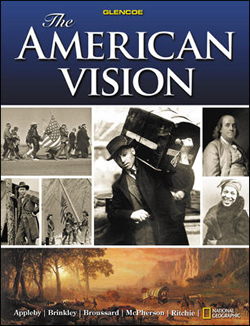The American Vision © 2008Chapter 23:
Post-War AmericaWeb Lesson PlansIntroduction
Students have read about the benefits that the federal government offered to
veterans of World War II under the GI Bill. In this activity students will
examine the GI Bill's impact on society and the economy.
Lesson Description
Students will use information from the Remembering the GI Bill Web site to learn
about the GI Bill's impact on society and the economy. Students will read about
the reasons why Roosevelt signed the GI Bill and about the ways it impacted
the economy, higher education, the suburbs, and the middle class. Students will
then answer four questions and apply this information by writing a comparison
of the postwar society and today's society that explains the GI Bill's social
and economic impacts.
Instructional Objectives- Students will explain the social and economic impacts of the GI Bill.
- Students will be able to use this knowledge to write a comparison of postwar
society and today's society that describes the GI Bill's social and economic
impacts.
Student Web Activity Answers- The benefits for veterans included education for any veteran who served
at least 90 days regardless of race or financial situation, low interest home
mortgages, business loans, and unemployment benefits. The GI Bill also established
veterans' hospitals.
- Because of the GI Bill, 8 million veterans flooded college campuses after
World War II. College registrations doubled compared to the 1940s, and schools
had to construct temporary housing to accommodate the new students. The new
faces on campus were older than traditional college students, and many would
not have been able to afford their education without the GI Bill. For the
institutions, increased enrollment meant the opportunity to expand.
- The GI Bill provided veterans with educational opportunities, which in turn
offered economic choices. Higher incomes coupled with the GI Bill's low-interest
loans created a huge market for new homes in the 1950s. Homes built in the
suburbs met the demands of these new homeowners. The ratio of homeowners in
the United States doubled from 1 in 3 before the war to 2 in 3 afterward,
and as the number of veterans purchasing new suburban homes increased, people
left the cities.
- The GI Bill fostered the growth of the middle class. Education, income opportunities,
and home ownership combined to improve the standard of living for many Americans.
More families were able to raise their children in comfortable environments
and to provide higher education for their children. Not all groups were able
to fully participate in the benefits of the GI Bill. African Americans still
faced segregated colleges and suburbs when they returned home from the war.
- Students' comparisons will vary.
 | 




